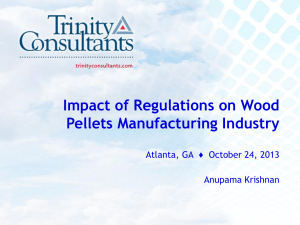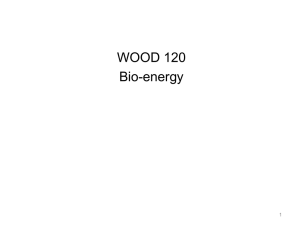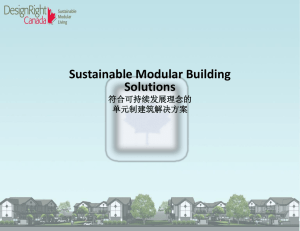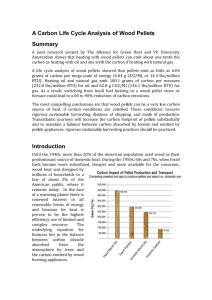Questionnaire of wood pellets product standard for industrial use
advertisement
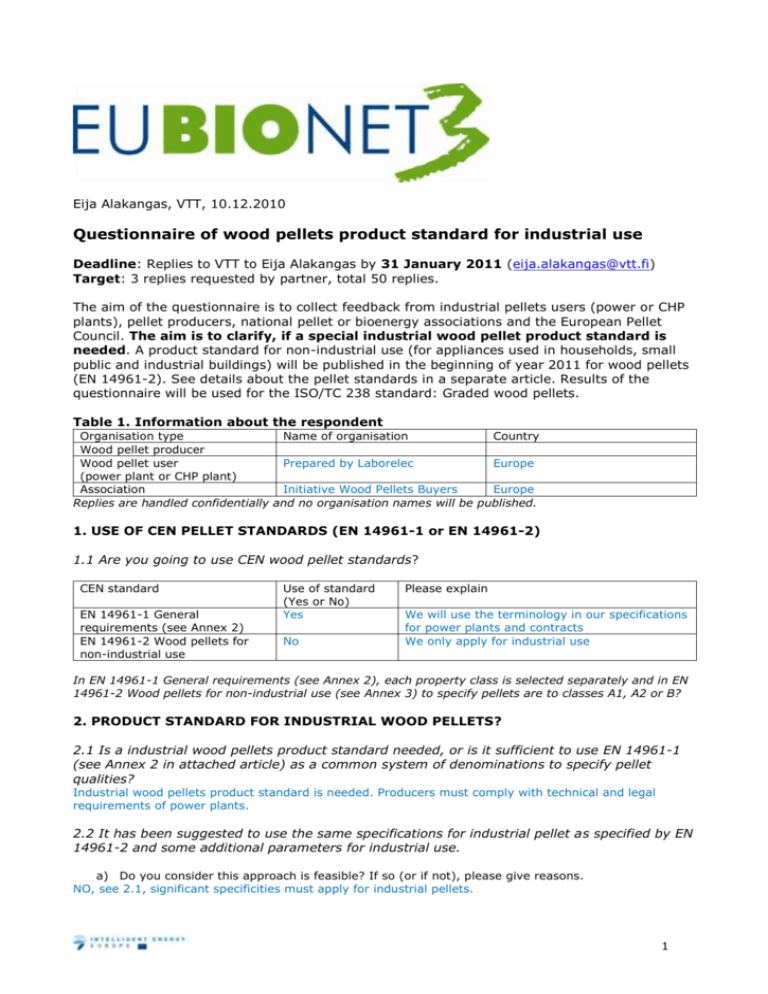
Eija Alakangas, VTT, 10.12.2010 Questionnaire of wood pellets product standard for industrial use Deadline: Replies to VTT to Eija Alakangas by 31 January 2011 (eija.alakangas@vtt.fi) Target: 3 replies requested by partner, total 50 replies. The aim of the questionnaire is to collect feedback from industrial pellets users (power or CHP plants), pellet producers, national pellet or bioenergy associations and the European Pellet Council. The aim is to clarify, if a special industrial wood pellet product standard is needed. A product standard for non-industrial use (for appliances used in households, small public and industrial buildings) will be published in the beginning of year 2011 for wood pellets (EN 14961-2). See details about the pellet standards in a separate article. Results of the questionnaire will be used for the ISO/TC 238 standard: Graded wood pellets. Table 1. Information about the respondent Organisation type Name of organisation Country Wood pellet producer Wood pellet user Prepared by Laborelec Europe (power plant or CHP plant) Association Initiative Wood Pellets Buyers Europe Replies are handled confidentially and no organisation names will be published. 1. USE OF CEN PELLET STANDARDS (EN 14961-1 or EN 14961-2) 1.1 Are you going to use CEN wood pellet standards? CEN standard EN 14961-1 General requirements (see Annex 2) EN 14961-2 Wood pellets for non-industrial use Use of standard (Yes or No) Yes No Please explain We will use the terminology in our specifications for power plants and contracts We only apply for industrial use In EN 14961-1 General requirements (see Annex 2), each property class is selected separately and in EN 14961-2 Wood pellets for non-industrial use (see Annex 3) to specify pellets are to classes A1, A2 or B? 2. PRODUCT STANDARD FOR INDUSTRIAL WOOD PELLETS? 2.1 Is a industrial wood pellets product standard needed, or is it sufficient to use EN 14961-1 (see Annex 2 in attached article) as a common system of denominations to specify pellet qualities? Industrial wood pellets product standard is needed. Producers must comply with technical and legal requirements of power plants. 2.2 It has been suggested to use the same specifications for industrial pellet as specified by EN 14961-2 and some additional parameters for industrial use. a) Do you consider this approach is feasible? If so (or if not), please give reasons. NO, see 2.1, significant specificities must apply for industrial pellets. 1 b) If feasible, which additional specifications should be required for industrial wood pellets? Please fill in the Table 2, which properties are needed for industrial wood pellets. If you consider that values can be same as in EN 14961-2, add this information in Comments column. See also Excel sheet attached. Those specifications will be THE reference for big 7 utilities in Europe. They have been agreed on our last IWPB meeting in Geneva on January 27 th. Particle size distribution and ash melting temperature are two important additional specifications for industrial pellets. c) If you consider industrial wood pellet classifications are needed and that they are different than specified by EN 14961-2, please fill in Table 3 and make your own proposal for a specification of industrial wood pellets. Again, see attached Excel sheet. 3. CERTIFICATION 3.1 The European Pellet Council is launching ENplus certification systems for non-industrial wood pellets, which is based on EN 14961-2 standard (see attached draft handbook). Is a certification system needed also for industrial wood pellets? GDFSUEZ/Laborelec is partner of PELLCERT project within IEE framework. a) Yes, explanation Yes, a certification system will help to achieve a constant technical quality, to guarantee best practices are carried out and will help integrating sustainability criteria that are verified at all steps of the supply chain b) No, explanation 3.2 If a certification system is needed for industrial wood pellets, what additional requirements or different requirements should it include compared to ENplus? Are there elements which are unnecessary and/or too expensive to measure in ENplus. See attached draft ENPlus handbook. Not all utilities in Europe do feel the necessity of a certification system because their position on certification has not yet been outlined fully. But some other utilities - like those having operations in BE, NL, UK - do feel this necessity. Key elements would then be as follows. - Constant wood pellets quality, especially ash content, chlorine, nitrogen, ash melting temperature, particle size distribution, mechanical durability and fines according to specs. - Raw material: Classification of the origin and sources of solid biofuels in accordance with EN 14961-2 (Table 1, EN 14961-1, see Annex XI). If the raw material does not exclusively originate from an affiliated sawmill, the suppliers and the origin of the raw material are to be specified according to EN 14961-1 Table 1. - Existence of a tracking system for the suppliers of raw material to the pellet plant. - Make the producer responsible for sustainable character of this raw material, especially when round wood or cultivated wood is used, especially as far as protection of carbon stock, biodiversity and soil quality is concerned. - Make the producer able to report on its energy use for evaluating GHG balance of the product. ENplus Green integrating those sustainability requirements would be more than welcome. 4. RAW MATERIAL REQUIREMENTS 4.1 Should chemically treated material* be allowed? If Yes, what would be the requirements for the material; or if No, why? Answer Yes No (mark X) Explanation X Power plants do not use contaminated wood and are not permitted for 2 * In EN 14961-1 classification of raw material (see Table 1 in article) chemically treated wood residues from wood processing (glued, painted, coated, lacquered or otherwise treated wood, 1.2.1) or used wood (1.3.2) is allowed as long as they do not contain heavy metals or halogenated organic compounds as a result of treatment with wood preservatives or coating. In EN 14961-2 chemically treated wood allowed only in class B (see Annex 3 in article), but same threshold values for heavy metals as for chemically untreated material to be met. In the ENplus certification no chemically treated wood is allowed. 5 3 . PRODUCT STANDARD FOR THERMALLY TREATED BIOMASS PELLETS 5.1 Do we need also product standard for thermally treated biomass pellets (e.g. torrefied pellets)? Answer Yes No (mark X) Explanation This is premature since the product has not been yet sufficiently tested at large scale and so specifications have not yet been designed 5.2 What properties should be specified? Make a list of properties (e.g. fixed carbon, particle size, moisture, net calorific value or what else), which you see most important. Key parameters will (probably) be: - net calorific value, - volatiles, - ash content, - ash melting temperature, and in addition for fire & explosion risk: MIE and KSt 4 Table 2. What are the most important quality requirements for industrial wood pellets? Shall they be normative (mandatory) or informative (voluntary) Property class Origin and source (raw material basis, see table 1 in article) Dimensions, diameter (D) and length (L) Moisture content, w-% wet basis (M) Ash content, w-% dry basis (A) Mechanical durability, w-% of pellets after testing (DU) Amount of fines, w-% (< 3,15 mm) (F) Additives, w-% of pressing mass, type and amount Bulk density, kg/m3 (BD) Net calorific value as received, MJ/kg (Q) or kWh/kg Nitrogen, w-% of dry basis (N) Sulphur, w-% of dry basis (S) Chlorine, w-% of dry basis (Cl) Arsenic, mg/kg dry basis (As) Cadmium, mg/kg dry basis (Cd) Chromium, mg/kg dry basis (Cr) Copper, mg/kg dry basis (Cu) Lead, mg/kg dry basis (Pb) Mercury, mg/kg dry basis (Hg) Nickel, mg/kg dry basis (Ni) Zinc, mg/kg dry basis (Zn) Ash melting behaviour, oC Particle size distribution Normative* (mark X) X Informative* (mark X) Comments (e.g. values of EN 14961-2 can be used) Important for sustainability and permitting X X X X Key quality parameter Min. And Max. Values for pulverising X X No additives allowed for legal reasons X X Essential since payment is directly related to this NOx problematics S is usually low in wood Corrosion ID of contaminated wood For recycled fly ash For recycled fly ash X X X X X X X X X X X X X Very important for slagging Very important for PP *Normative=mandatory property class, Informative= voluntary property class 5 Table 3. Proposal for the specification of wood pellets for industrial use Replace X by your own proposal (number, see model from Annex 3 in attached article). If you find some property class unnecessary, mark it by strikethrough. Property class, Analysis method Unit I1 I2 All types of clean wood by-products and residues allowed 1.1 Forest, plantation and other virgin wood, 1.2 byproducts and residues 1.1 Forest, plantation and other virgin wood, 1.2 by-products and residues mm D06 to D08 D06 to D08 L < 4,0 L < 4,0 as received, w-% wet basis M10 M< 10% M10 M< 10% w-% dry A 1.0 A< 1,0% A 2.0 A< 2,0% Mechanical durability, DU, EN 15210-1 as received, w-% DU97.5 – max. 99 DU96.5 – max. 99 Fines F, EN15210-1 The amount of fines shall be checked when the pellets leave the final point of loading for delivery to the enduser. i.e when loading at the harbour w-% as received Origin and source (see table 1 in attached article and Annex 3 ) Diameter, D a and Length L, b prEN 16127 Moisture, M EN 14774-1, EN 14774-2 Ash, A EN14775 F4.0 F4.0 F< 4,0% F< 4,0% w-% dry None None as received, MJ/kg Q16.5 Q>16,5 Q16.5 Q>16,5 kg/m3 BD600 > 600 BD600 > 600 Nitrogen, N, FprEN 15104 w-% dry N0.5 < 0,5 N1.5 < 1,5 Sulphur , S, FprEN 15289 w-% dry S0.05 < 0,05% S0.4 < 0,4% Chlorine, Cl, FprEN 15289 w-% dry Cl0.03 < 0,03% Cl0.1 < 0,1% Arsenic, As, FprEN 15297 mg/kg dry <2 <6 Cadmium, Cd, FprEN 15297 mg/kg dry < 1,0 < 10 Chromium, Cr, FprEN 15297 mg/kg dry < 15 < 50 Copper, Cu, FprEN 15297 mg/kg dry Lead, Pb, FprEN 15297 mg/kg dry Mercury, Hg, FprEN 15297 mg/kg dry Nickel, Ni, FprEN 15297 mg/kg dry Zinc, Zn, FprEN 15297 mg/kg dry 1200 1100 100% >97% >95% >75% >50% < 3% 100% >97% >90% Normative Additives c Net calorific value, Q, EN 14918 Bulk density, BD, EN 15103 Ash melting behaviour, d prEN15370, DT Informative Particle size distribution, prEN15149 % < 4.0 mm % < 3.15 mm % < 2.0 mm % < 1.5 mm % < 1.0 mm % < 0.1 mm o C w-% dry >50% < 5% a Selected size of pellets to be stated. Amount of pellets longer than 40 mm can be 0 w-%. Maximum length shall be < 40 mm. c Type (e.g. starch, corn flour, potato flour, vegetable oil): no additives allowed, exceptionally pure vegetal additives could be accepted <5% d All characteristic temperatures (shrinkage starting temperature (SST), deformation temperature (DT), hemisphere temperature (HT) and flow temperature (FT) in oxidizing conditions should be stated. b Note: for raw material specification use Table 1 in article (see model of Annex 3). If you do not allow chemically treated material select classes from 1.2.1 and 1.3.1. 6



